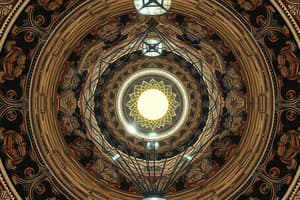Podcast
Questions and Answers
What is the term used for the point on the reflecting surface of a spherical mirror called?
What is the term used for the point on the reflecting surface of a spherical mirror called?
- Centre of curvature
- Focal point
- Centre of reflection
- Pole (correct)
Where does the centre of curvature of a concave mirror lie in relation to the mirror?
Where does the centre of curvature of a concave mirror lie in relation to the mirror?
- Inside the mirror
- Behind the mirror
- On the mirror
- In front of the mirror (correct)
What is represented by the letter 'C' in the context of spherical mirrors?
What is represented by the letter 'C' in the context of spherical mirrors?
- Radius of curvature (correct)
- Centre of reflection
- Focal length
- Centre of curvature
Which type of mirror has its centre of curvature behind the mirror?
Which type of mirror has its centre of curvature behind the mirror?
In the sign convention for reflection by spherical mirrors, what does a negative radius of curvature indicate?
In the sign convention for reflection by spherical mirrors, what does a negative radius of curvature indicate?
What is meant by the focal length of a spherical mirror?
What is meant by the focal length of a spherical mirror?
What happens to an object placed at the focal point of a concave mirror?
What happens to an object placed at the focal point of a concave mirror?
What type of image do convex mirrors generally produce?
What type of image do convex mirrors generally produce?
Which type of mirror is commonly used in headlights and torches to produce a parallel beam of light?
Which type of mirror is commonly used in headlights and torches to produce a parallel beam of light?
In which situation would you use a convex mirror over a concave mirror?
In which situation would you use a convex mirror over a concave mirror?
Flashcards are hidden until you start studying
Study Notes
Sign Convention for Reflection by Spherical Mirrors
- The New Cartesian Sign Convention is used for spherical mirrors, where the pole (P) of the mirror is taken as the origin.
- The principal axis of the mirror is taken as the x-axis (X'X) of the coordinate system.
- The object is always placed to the left of the mirror, with light from the object falling on the mirror from the left-hand side.
- Distances parallel to the principal axis are measured from the pole of the mirror.
- Distances to the right of the origin (along +x-axis) are taken as positive, while those to the left of the origin (along –x-axis) are taken as negative.
- Distances measured perpendicular to and above the principal axis (along +y-axis) are taken as positive, while those measured perpendicular to and below the principal axis (along –y-axis) are taken as negative.
Mirror Formula and Magnification
- The distance of the object from the pole of a spherical mirror is called the object distance (u).
- The reflecting surfaces obey the laws of reflection.
- The mirror formula is 1/u + 1/v = 1/f, where u is the object distance, v is the image distance, and f is the focal length.
- The focal length of a spherical mirror is equal to half its radius of curvature.
- The magnification produced by a spherical mirror is the ratio of the height of the image to the height of the object.
Spherical Mirrors
- A concave mirror is curved inwards, and its centre of curvature lies in front of it.
- A convex mirror is bulged outwards, and its centre of curvature lies behind it.
- The pole of a spherical mirror is the point on the surface of the mirror, represented by the letter P.
- The centre of curvature is the point at the centre of the sphere of which the reflecting surface of a spherical mirror forms a part, represented by the letter C.
- The radius of curvature of a spherical mirror is the radius of the sphere of which the reflecting surface forms a part, represented by the letter R.
Studying That Suits You
Use AI to generate personalized quizzes and flashcards to suit your learning preferences.




